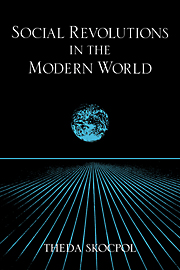Book contents
- Frontmatter
- Contents
- Acknowledgments
- INTRODUCTION
- I DOING MACROSCOPIC SOCIAL SCIENCE
- II MAKING SENSE OF THE GREAT REVOLUTIONS
- 4 Explaining revolutions: In quest of a social-structural approach
- 5 Revolutions and the world-historical development of capitalism
- 6 France, Russia, China: A structural analysis of social revolutions
- III A DIALOGUE ABOUT CULTURE AND IDEOLOGY IN REVOLUTIONS
- IV FROM CLASSICAL TO CONTEMPORARY SOCIAL REVOLUTIONS
- CONCLUSION
- Index
4 - Explaining revolutions: In quest of a social-structural approach
Published online by Cambridge University Press: 05 June 2012
- Frontmatter
- Contents
- Acknowledgments
- INTRODUCTION
- I DOING MACROSCOPIC SOCIAL SCIENCE
- II MAKING SENSE OF THE GREAT REVOLUTIONS
- 4 Explaining revolutions: In quest of a social-structural approach
- 5 Revolutions and the world-historical development of capitalism
- 6 France, Russia, China: A structural analysis of social revolutions
- III A DIALOGUE ABOUT CULTURE AND IDEOLOGY IN REVOLUTIONS
- IV FROM CLASSICAL TO CONTEMPORARY SOCIAL REVOLUTIONS
- CONCLUSION
- Index
Summary
The explanation of revolutions poses a unique challenge for social science. Success depends upon finding some way to hypothesize about complex, largescale events in which patterned group conflicts and sudden societal transformations intrinsically coincide. Undoubtedly the most difficult cases are social revolutions, in which societal political conflicts occurring in conjuncture with class upheavals from below lead to “rapid, fundamental, and violent domestic change in the dominant values and myths of a society, in its political institutions, social structure, leadership, and government activities and policies” (Huntington, 1968:264). To be sure, the historical occurrences that unequivocally measure up to this definition are few: France, 1789; Russia, 1917; Mexico, 1911–1936; and China, 1911–1949 are the obvious clear-cut instances. Many would argue that a phenomenon of which there are so few instances does not deserve theoretical attention. Yet the enormous impact and continuing historical significance of social revolutions are surely sufficient to override the fact of their generic scarcity and render them a fit object of explanatory effort for social scientists.
What explains revolutions? Why do they (or might they) occur in certain societies at given times, while not in other societies, or at other times in the same societies? Apparently, recent American social science should have much to say in answer to this question, for, like a hundred flowers blooming, theories of revolution have sprung up thick and fast during the past fifteen years.
- Type
- Chapter
- Information
- Social Revolutions in the Modern World , pp. 99 - 119Publisher: Cambridge University PressPrint publication year: 1994



